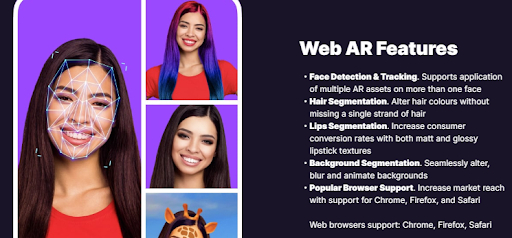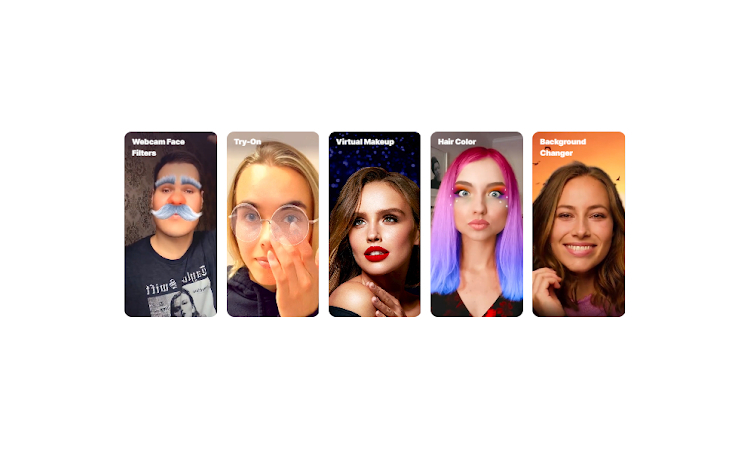At the moment, the technology is inferior to augmented reality in the form of individual software tools, but it is rapidly evolving, literally before our eyes.
Areas of technology application
Despite the still limited capabilities, AR for Web has a wide range of uses in various fields, such as:
- Advertising. This is the most obvious point of application of augmented reality elements. The technology has produced a real innovation in marketing: studies show that the use of AR in commercial advertising increases the probability of clicking on a link by dozens of percent. Moreover, interactive advertising does not cause the negativity and rejection that are typical for ordinary banners.
- Education. Augmented reality allows you not only to create any manuals, including those inaccessible in physical reality, but it also allows users to interact with them, receiving feedback. The learning process becomes more engaging and interesting. As for the augmented reality on the Web, it helps bring all the AR advantages to online learning via the Internet.
- Entertainment. In this segment the applicability of augmented reality is unquestionable. Its popularity is largely due to the resounding success of the PokemonGo game. Perhaps, the Web augmented reality will revive the withering class of browser-based online games. And do not forget that AR involves not only the visual channel, but also makes it possible to interact with objects by voice, such as voice control.
- Commercials. The flip side of AR advertising is more effective business management. With the help of Web AR it is possible to easily track, count and analyze the number of ad views and link clicks, calculating the sales funnel.
And this is only a small part of the industries where innovative technology can be leveraged
How Does It Work
Augmented reality technology in the Web has a lot of nuances concerning the development and implementation, since it implies the contact of virtual reality objects with the physical reality. First of all, you need a clear definition of the spatial position and orientation of the user's device. Without this, it is impossible to synchronize the image of virtual objects in accordance with the surrounding interior. Information about the environment is collected by the camera, it is necessary to ensure translation of the data from the camera into the Web environment.
It is not enough to draw virtual objects over an image. To create the illusion of presence, it is necessary to recognize the surface on which the object can be "placed". Only in this case, the illusion of presence in the real world will be achieved. If the virtual object being broadcast is three-dimensional and allows the user to view it from different angles, it is necessary to ensure real-time tracking of the user device's orientation changes in space and accurately synchronize those changes with the object's rotation.
Although augmented reality on the Web does not require the installation of special software tools, it may be necessary to have a software framework on the device, such as AR Core for Android and its functional counterpart for iOs, AR Quick Look. Browser-based augmented reality often uses cloud libraries, in particular, filters in Instagram and masks in FB messenger are based on it.
In addition to the software basis, augmented reality imposes additional requirements on the "hardware". In particular, the device must have a camera, accelerometer and gyroscope. Although most modern gadgets are equipped with these sensors, they do not always have sufficient accuracy and clarity.
Augmented reality imposes higher requirements for computer vision, both in terms of computer hardware and recognition software. This is especially true if the binding of virtual objects to real objects is carried out without special labels - QR-codes, paper clock models and similar "crutches". The most difficult task is to work with a human face.
It requires not only recognition of the face as an object as a whole, but also its individual parts - lips, eyes, eyebrows. Recognition of various emotions is especially important. If digital cameras of the beginning of zero years could recognize a smile, then today's software should be able to distinguish sadness, joy, surprise, fright and other emotions.
AR in browser — limitations of the technology
Despite the significant progress in recent years and the obvious advantages associated with the lack of need to download and install special apps, the AR in browser has some restrictions:
- Low performance. While the software can ( in theory) use all the resources of the device, the browser gets only a relatively small part of them. Unlike installed applications, the browser version of augmented reality has significant limitations on the amount of information transferred, which also makes adjustments. In particular, there may be problems with building a "fair" 3D model. The rotation effect is achieved by alternating flat images, like it was implemented in old shooter games.
- Limited functionality. If the software can access all the features of the device with the user's permissions, the AR functionality in the browser is quite limited in terms of the available functions. This has an impact on the final result: for example, the placement of virtual objects on the user's desk with browser-based augmented reality tools is quite possible, but there can be serious problems with the simulation of complex movements, especially if the user is actively changing the angle of view. The software cannot keep up with the physical changes, which leads to the destruction of the illusion.
- Limited traffic. As mentioned, browser-based AR often uses cloud libraries, which requires large amounts of data to be exchanged quickly. If the limitations on the amount of Internet traffic is now rather the exception, the channel width still often leaves much to be desired. This is especially true for data transmission via the mobile network in the absence of a Wi-Fi access point within reach.
This list of limitations outlines the range of challenges developers will have to solve in the near future.
Banuba's Web AR Development Tools
Banuba offers not only ready-made augmented reality solutions, but also a set of tools for developing and implementing AR elements both in separate apps and in the Web environment.
The Web AR SDK is a developer's toolkit for creating a browser-based version of augmented reality. It takes into account all the features and limitations mentioned above, which guarantees high efficiency and effectiveness in the Web environment.
The kit includes:
- library of face-mask filters;
- smart beautifier filters;
- tools for working with interior;
- 3D rendering tools;
- static and animated stickers.
Any object in the library is available for editing. The toolset also allows you to easily create and add your own objects to the library.








